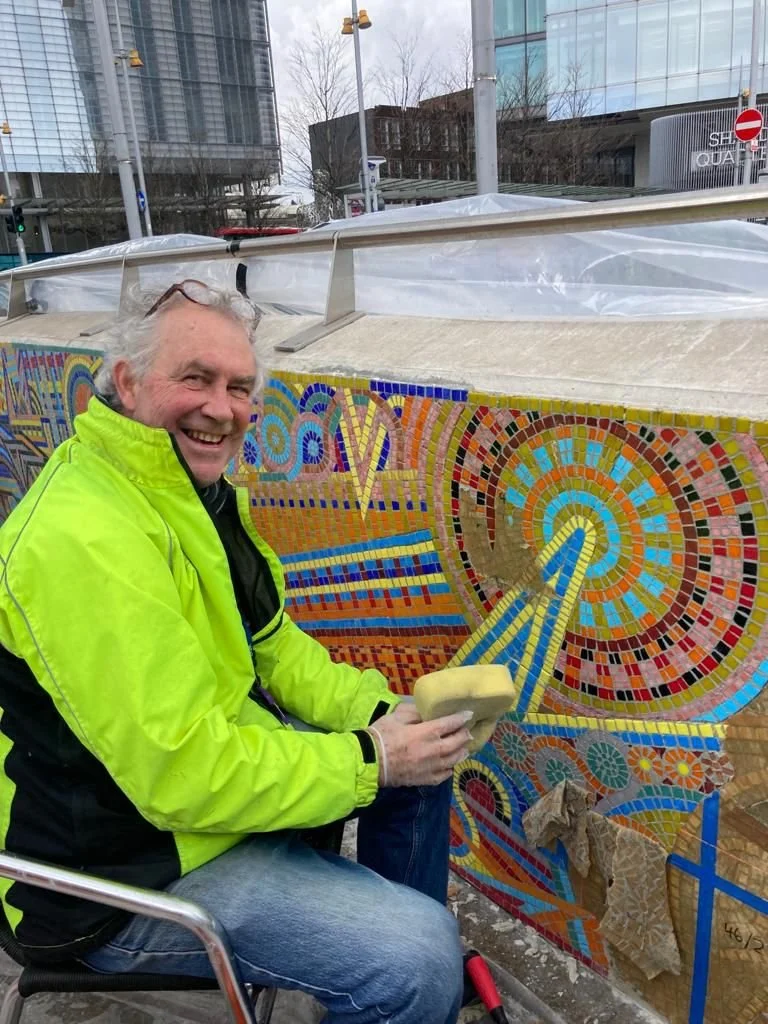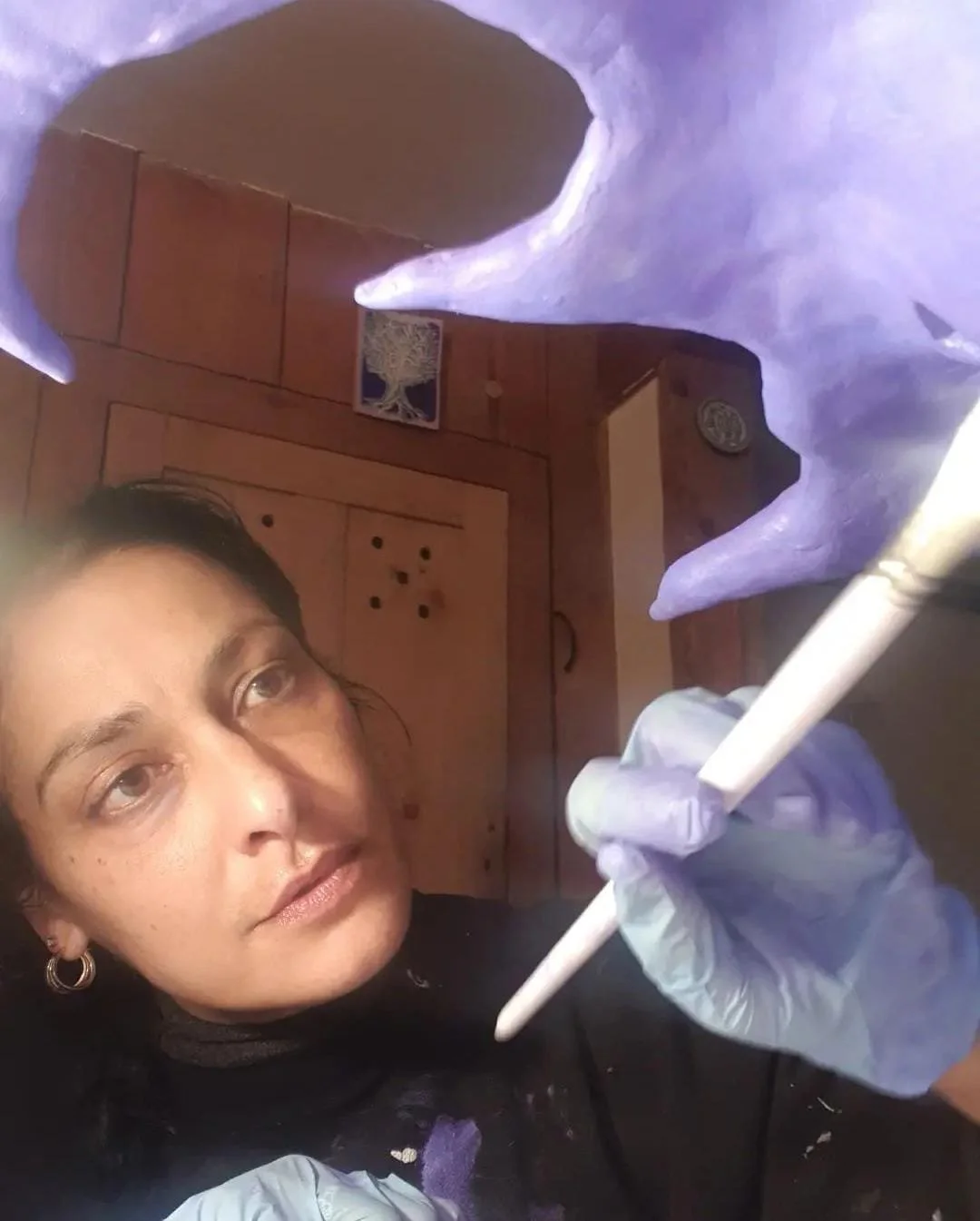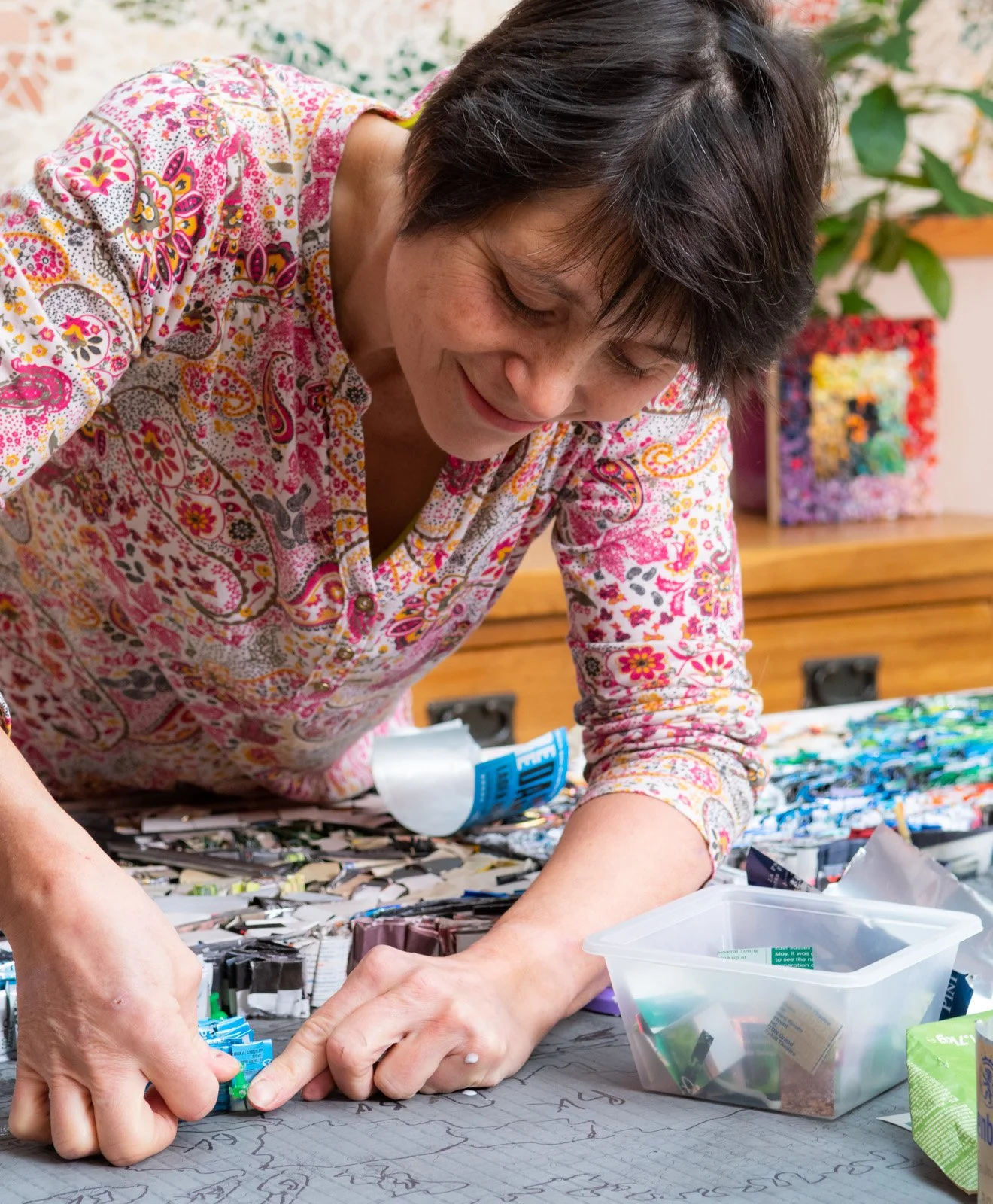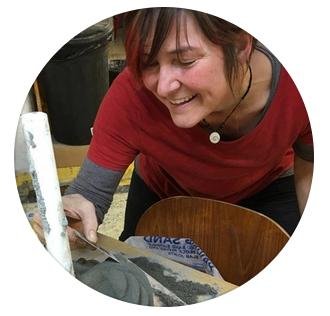
Statement
Art Reviews
Testimonials
Eco-artivist. Rubbish artist. Eco-mosaicist.
I pioneer sustainable art since 2017 and I create my artworks entirely out of waste: my trashure.
Torn between optimism and surrender, I believe in a future of resourceful innovation through systemic re-thinking. This hope is made visible through my work: for me, art is meaningful rather than beautiful, but the more beautiful the artwork, the clearer the message. Every tessera I create protests against our disposable lifestyle, providing a new perspective on rubbish and embodying hope. In my world, rubbish gains new value, transforming from waste to wonder.
I enjoy working within ethical and material limitations, using materials that often take years to gather. I extend the legacy of my 3D artworks into a multi-faceted narrative through staged photography.
Gesamtkunstwerk, my eco-artivism encompasses every aspect of my life: vegan, using 100% renewable energy, wearing second-hand clothes, being plastic-free wherever possible, seeking local food, saving water, growing a vegetable and wildlife garden, experimenting with permaculture, fostering a passion for evolutionary ecology and vegetal neurobiology, and not flying for 4 years (though the counting has recently reset).
I realize my synthetic artworks might seem antithetic to my values, but I find organic material too precious to use. I avoid displacing it from its original state or removing it from the ecosystem altogether.
In short, I want to minimise plunder and maximise my impact, pushing the boundaries of both mosaic and fine art, making them accessible to everyone, turning shame into wonder, and provoking real change.
I view art as a dynamic conversation and an exceptional means to engage with a wide audience. It has the power to create a network that spans all facets of society, enabling efficient collective efforts towards the common good of the entire ecosystem.
Art Reviews
Anthony Fawcett, 2024
"Possibility is sustained by one's intuition for invention-and for invention to flourish, one must be fiercely independent" (Hans Ulrich Obrist in an interview with James Lovelock, 'Ever Gaia', 2023).
Francesca Busca, an ex-City lawyer, changed careers in 2015, deciding to become an artist, a childhood ambition, always drawing, and in 2019 she graduated from the London School of Mosaic. But out of this newfound talent, she decided to put her energy, and her art, into basically "saving the planet." Busca became, in her own words, an 'Eco-Artivist,' or 'Rubbish Artist!' I prefer the former label.
Busca began creating her sculptures and installations entirely out of waste. She quickly became a master of this art form, a veritable "gesamtkunstwerk" that included her own and her family's lives as vegans.
I am reminded of the artist Hundertwasser, who reclaimed the soil for his artworks and built underground, and the seminal German artist and activist of the 20th century, Joseph Beys (I interviewed both of them).
Busca's materials are predictable: plastic cutlery, bottle tops, fruit nets, medicine vials, and, yes, discarded bones! In a permanent installation at a school, she used 8,000 screw tops in a work entitled "Flow of Life." And in a work entitled "LIVe and let LIVe," her materials were 100% waste, utilizing thousands of crown caps and hundreds of corks, overlaid with organic paints. Other highlights include a tongue-in-cheek sculpture made out of "100% Crisps and Popcorn"!
But Busca's impressive body of work around the planet is both poignant and topically important, as climate change is on all our minds. "Everything I create is in itself a beacon of hope," she has stated. "My quest is to push the boundaries of both mosaics and fine art and make them accessible to everybody!"
Busca is soon to collaborate with the Institute of Marine Sciences in Venice for the upcoming Boat Show, a project I look forward to. And she is continually running 'Pro-Bono' projects on "eco-awareness." | truly salute her as a visionary artist so in tune and in touch with the huge problems we face as a planet in the future, and her art and message are that we can do something about it now!
Tabish Khan, May 2024
“The chocolate bar wrapper, the disposable coffee cup, the furniture that we replace because it looks a little tatty.
We live in an age where most of us are producing waste at a monumental level. Francesca Busca is not most of us and her commitment to live a sustainable life extends to her art where she repurposes hairdresser's foils, papers and magazines, cork, leftover paint, bottle caps and crisp and popcorn packers to create art that promotes sustainability. She will work with clients to create art from their own waste and will even accept eco-friendly actions in lieu of payment for her art. Creating the words 'love' and 'live' out of rubbish it's both a critique of how wasteful we can all be, but also a beacon of optimism as it's now well known that we're facing an ecological crisis and Francesca remains optimistic that we can find a way to address the climate crisis. Her message is clear - make art, not waste.”
Marta Puig, February 2024
“Francesca Busca’s art is a harmonious fusion of environmental activism and aesthetic inquiry, a practice where waste is not an end, but a beginning.
As an Eco-artivist and mosaicist, she embraces the detritus of daily life, transforming discarded objects into tesserae of a larger socio-environmental commentary. Her work, which she dubs as 'trashure,' is a testament to the transformative power of art, urging a re-examination of what is deemed valuable or beautiful.
Busca's art is steeped in the tradition of mosaic, a form that dates back to ancient times, but she infuses it with a contemporary urgency. Her approach could be likened to the Dadaists, who incorporated everyday objects into their art to challenge notions of what art should be. Yet, unlike the often disquieting work of the Dadaists, Busca's creations exude a hopeful tenor, echoing the ethos of Arte Povera in her use of non-traditional materials to forge a connection between life, art, and nature.
Her commitment to sustainability extends beyond her artwork into her lifestyle, embodying the change she wishes to see in the world. This personal integration of principles is reminiscent of the way artists like Gustav Klimt and the Vienna Secession brought art into everyday life, blurring the lines between art and living. By positioning beauty as a vehicle for environmental commentary, Busca follows in the footsteps of artists like Andy Goldsworthy, whose site-specific works engage with nature's temporality. However, while Goldsworthy's works often fade back into the environment, Busca's art arrests the decay, freezing it in a state of rebirth.
Francesca Busca's art is a clarion call to a society inundated with consumption and waste. Her pieces are not merely objects to behold but are conversations, provocations, and invitations to witness the metamorphosis from refuse to resource. In the lineage of great artists, she stands out for her unwavering commitment to not just create art for art’s sake, but for the sake of the planet. She holds a mirror to contemporary society, showing that from the refuse can emerge beauty, and with beauty, a powerful message of conservation and transformation.
Francesca Busca’s work is not merely a collection of objects arranged to please the eye; it is a profound narrative about sustainability, consumerism, and the potential for transformation that lies in what we discard. Her title as an 'Eco-artivist' and 'Rubbish artist' is not merely a label but a profound statement of her mission: to challenge the disposability of modern life and present an alternative through the lens of art. Busca's works are a radical testament to the idea that waste does not exist as a mere endpoint but rather as a raw material for innovation and artistic expression.
Busca’s "trashure" embodies a new aesthetic, one that finds beauty in the discarded and sees potential in the rejected. Each piece she creates is a tapestry woven from the cast-offs of daily life, each telling its own story and collectively narrating the tale of a consumerist society. She stands as a pioneer, not in the discovery of new materials, but in the re-discovery of value in what is often overlooked.
In her art, one can see echoes of the early 20th-century Dada movement, which sought to upend traditional conceptions of art and aesthetics by introducing everyday objects into the art world. The Dadaists, much like Busca, utilized found objects to create their works, challenging the status quo of what art could be and what materials it could use. However, while Dada was born out of the chaos and disillusionment of World War I, Busca’s work springs from an earnest hope for the future, a belief in humanity's capacity to reinvent and repurpose its way into ecological harmony.
Her style also shares a kinship with Arte Povera, the Italian movement that emerged in the 1960s, which saw artists using commonplace materials to challenge and disrupt the commercialization of the art world. Like the artists of Arte Povera, Busca employs non-traditional materials, but her focus is on the environmental narrative they carry, weaving them into a commentary on the excesses of modern life.
The comprehensive lifestyle she leads, from being a vegan to avoiding air travel, is a personal reflection of the philosophies she embeds within her art. This holistic approach is evocative of the Gesamtkunstwerk, or "total work of art," concept popularized by the Vienna Secession, which aimed to synthesize all arts and aspects of life into a unified whole. In Busca’s case, life itself becomes an artistic practice, a living installation that exhibits the principles she holds dear.
Busca's commitment to creating a sustainable future through art recalls the intentions of artists such as Andy Goldsworthy, whose ephemeral nature sculptures highlight the transient beauty of the natural world. But where Goldsworthy’s works often dissolve back into the earth, Busca's art halts the cycle of decay and reconfigures what would be ephemeral trash into enduring art. Her work, thus, not only comments on the transient but actively participates in the conversation of permanence and preservation.
Busca’s art also resonates with the philosophy of William Morris, the 19th-century artist and thinker who believed that art should be a part of everyday life and should contribute to the betterment of society. Morris advocated for craftsmanship in the face of industrial mass production, and while Busca uses mass-produced waste, she too champions the handmade, the crafted, and the personal touch. In her tesserae, one can feel the meticulous care and attention to detail that echoes the Arts and Crafts movement’s ethos.
The vivid colors and intricate patterns that characterize her work are not unlike the stained glass of Louis Comfort Tiffany or the modernist paintings of Wassily Kandinsky. However, unlike these artists who often used expensive or high-quality materials, Busca finds her palette in the refuse bin. She challenges the notion that art must be made from precious materials to be valuable. Instead, she proposes that the value lies in the vision of the artist and the message conveyed.
Busca is not only an artist but also a visual activist, and her work is her protest. Each composition is an act of defiance against a throwaway culture, a call to arms to reconsider our relationship with material possessions and the environment. In this sense, her work aligns with the concept of "art as a social practice," where the role of the artist extends beyond creation to include engagement and community impact.
In her work, we see not just the transformation of materials but also the potential for societal transformation. Busca’s mosaics do not simply repurpose waste; they question why we create so much waste in the first place. Her art is a dialogue with the viewer, an invitation to reflect on personal habits and societal norms. It asks us to consider the life cycle of our belongings and to find beauty and worth in what we would normally discard without a second thought.
Francesca Busca’s artworks serve as a striking intersection between creative expression and environmental activism, a synthesis that resonates with the eco-conscious movements of the 21st century. Her unique brand of artistry, which transforms what society discards as waste into captivating mosaics, redefines the concept of beauty and utility in art. As an Eco-artivist, 'Rubbish artist,' and mosaicist, Busca pioneers a form of sustainable art that is not only visually compelling but also ideologically provocative.
In a world where consumerism leads to massive waste generation, Busca's 'trashure' art presents a poignant narrative on the potential for transformation. Her art is an amalgamation of optimism and a sense of critical urgency, a duality that echoes the human condition's struggles with its own unsustainable practices. Like the haunting specter of mankind's possible self-destruction, her work is imbued with a sense of looming dread, yet it's simultaneously counterbalanced by a belief in the resilience and innovative spirit of humanity.
The aesthetically appealing nature of her work serves a dual purpose—it captivates the viewer while simultaneously delivering a potent environmental message. This is art as protest, a peaceful yet powerful rebellion against a disposable culture. Each piece she creates is a meticulous construction of waste, carefully repurposed and arranged to challenge our perceptions. In Busca's hands, materials that would otherwise contribute to landfill or pollution acquire new value, transformed into the centerpiece of artistic expression.
Busca's eco-artivism is not limited to her art; it permeates every facet of her life. This holistic approach is reminiscent of historical movements such as the Arts and Crafts movement of the late 19th and early 20th centuries, which advocated for a union between art and life, and a resistance to the dehumanizing effects of industrial mass production. Francesca’s art and lifestyle choices parallel this movement’s principles, as she adopts a vegan diet, wears second-hand clothing, and lives as sustainably as possible.
The comparison between Busca and famous artists across history is inevitable when considering the impact and the thematic core of her work. For instance, one may draw parallels between her and the works of the great Impressionists, who sought to capture fleeting moments and the transitory effects of light. In a similar vein, Busca captures the ephemeral nature of our consumer products, repurposing them to give them a new, enduring form.
Like Joseph Beuys, who believed in the social, cultural, and political potential of art, Busca sees her work as a tool for change. Beuys’s famous quote, "Everyone is an artist," can be reframed in the context of Busca’s philosophy as "Everyone is an eco-artivist." She invites us to see the artist in ourselves, capable of creating change, not just through traditional forms of artistic expression but also through the choices we make in our daily lives.
Busca's art can be seen as a contemporary embodiment of Marcel Duchamp's readymades, where ordinary manufactured objects are elevated to the status of art. Yet, while Duchamp's work was a challenge to the established art world and its conventions, Busca challenges the established world order itself, advocating for a reconsideration of our relationship with the environment.
The intricate detail and labor-intensive process of Busca’s mosaics are reminiscent of the pointillist techniques of Georges Seurat, where small, distinct dots of color are applied in patterns to form an image. Busca's meticulous placement of waste materials is her form of 'pointillism,' with each piece of rubbish serving as a dot in a larger, environmentally conscious image.
In comparison to the dramatic, dynamic compositions of Baroque artists like Caravaggio, who used the interplay of light and shadow to convey emotion and narrative, Busca employs the inherent textures and colors of recycled materials to bring depth and story to her pieces. Her work, much like Caravaggio's, is a dialogue of contrasts: the discarded versus the valued, the transient versus the eternal.
The social commentary found in the work of Francisco Goya, who used his art to reflect on the turmoil and social changes of his time, also finds a modern echo in Busca's work. Where Goya used his brush to depict the follies and corruptions of society, Busca uses her 'trashure' to critique contemporary excesses and wastefulness.
Similarly, her art reflects the ethos of William Morris, the 19th-century designer and social activist who believed in the beauty of handcrafted objects and the integrity of natural materials. Busca, too, champions the value of the handmade, her art a deliberate and thoughtful antithesis to the mass-produced and disposable.
In the lineage of environmental art, Busca's work stands as a poignant testament to the power of art to initiate dialogue, provoke thought, and inspire action.
Francesca Busca's art holds a critical place within the contemporary art scene as it bridges aesthetics with an urgent environmental message, a synthesis that reflects the zeitgeist of the modern era. Her work is important for several reasons:
At a time when environmental concerns are at the forefront of global discourse, Busca’s art brings these issues into the intimate space of daily life and personal reflection. By using waste materials as the primary medium, her art becomes a direct commentary on the throwaway culture that contributes to ecological degradation. Busca's methodology is innovative; she has taken the ancient art of mosaic and revitalized it with materials that have a modern narrative. This inventive approach places her within a lineage of artists who have pushed the boundaries of traditional mediums and practices.
Her work acts as a mirror to contemporary society, reflecting the issues of consumerism and waste that are often overlooked. This reflection is vital within the art scene as it encourages viewers to engage with the art on a level that transcends pure aesthetics, prompting a deeper societal introspection. Through her art, Busca educates her audience about sustainability and the potential for repurposed materials. The educational aspect of her work is crucial in an era where information can catalyze change, making her pieces not only visually stimulating but also intellectually and socially stimulating. Busca's life and art are inseparable, a trait that aligns her with artists like Frida Kahlo, whose personal experiences deeply informed their work. Busca’s sustainable lifestyle choices reinforce the authenticity of her message and demonstrate her commitment to the ethos she portrays in her art.
Her work breaks down barriers between 'high' art and the community, making her art accessible and relatable. This democratic approach ensures her message reaches a broad audience, amplifying its impact. Busca’s work contributes to an ongoing dialogue about the role of art in society and its potential to effect change. Her presence in the art scene is a reminder that art can be both beautiful and a catalyst for social and environmental transformation.
Paolo Levi, 2017
“Francesca Busca possiede una grande talento espressivo che le consente non solo di fare arte, ma anche di instaurare un vero e proprio rapporto con il pubblico, rendendolo partecipe delle sue opere affrontando spesso tematiche sociali che riguardano tutti.
Il suo gesto creativo è modulato con grande efficacia segnica, e da esso è facile capire che tipo di ricerca segnica abbia condotto l'artista e decifrarne di conseguenza, il linguaggio simbolico ed articolato. Un'artista versatile che sfrutta il proprio talento come spunto di riflessione per l'astante, affermando una forte contemporaneità di stile.”
—-
Francesca Busca possesses a great expressive talent which allows her not only to make art, but also to establish a real relationship with the public, making them participate in her works, often addressing social issues that concern everyone. Her creative gesture is modulated with great sign effectiveness, and from it it is easy to understand what type of sign research the artist conducted and consequently decipher the symbolic and articulated language. A versatile artist who uses her talent as food for thought for the bystander, affirming a strong contemporaneity of style.
Testimonials












